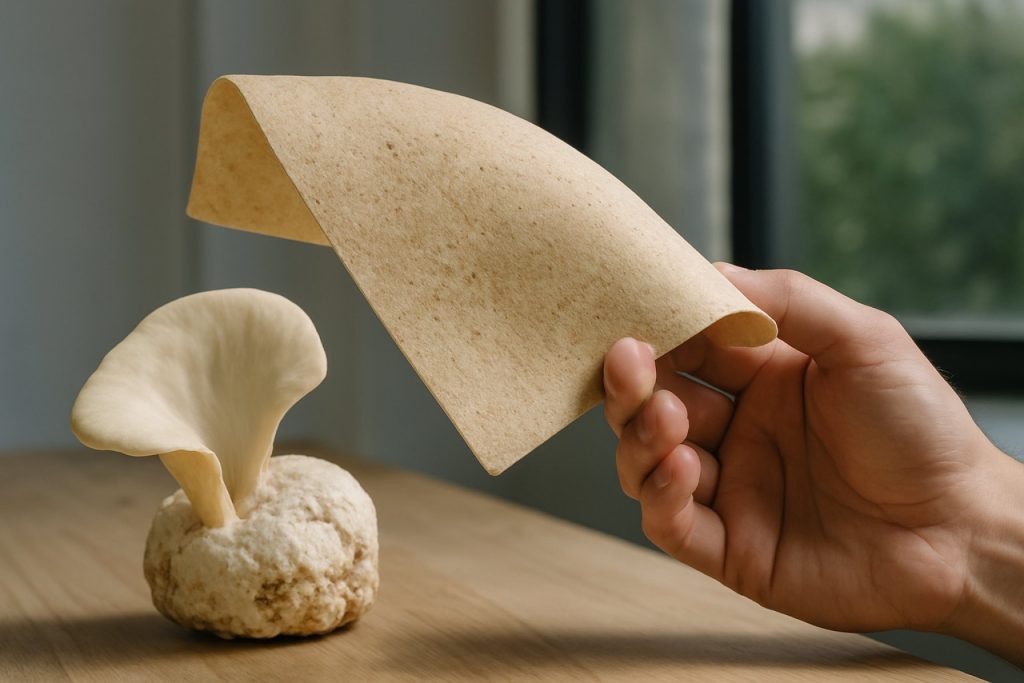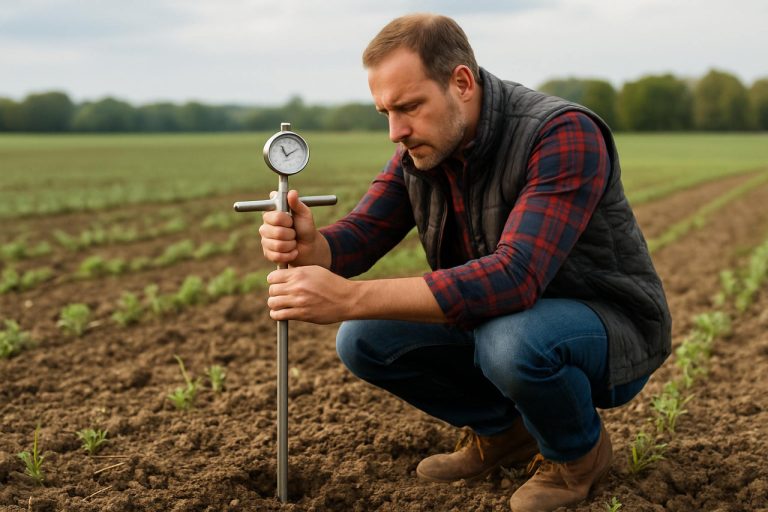
- Mycelium-based materials, cultivated from the split-gill mushroom (Schizophyllum commune), offer a biodegradable, high-performance alternative to conventional plastics.
- These “living plastics” are produced by fungal growth, not synthetic processes, eliminating the need for harsh chemicals and costly extractions.
- Mycelium films provide strong, flexible, and tear-resistant qualities, making them suitable for packaging, electronics, and single-use items.
- Natural emulsifying proteins allow for stable, edible emulsions, expanding uses in food and cosmetics industries.
- The material is fully compostable and can even aid decomposition, offering a unique advantage over many other “biodegradable” plastics.
- Properties like strength, flexibility, and biodegradability can be fine-tuned by adjusting fungal strains and growth conditions, opening doors to advanced electronics and sustainable batteries.
- Mycelium materials represent a transformative step toward a circular economy, where everyday products safely return to the environment.
Against the hum of laboratory equipment, a new material quietly emerges from the tangle of tangled white threads beneath a petri dish. It is neither plant nor animal, but a living network—mycelium—forming the foundation of a new generation of biodegradable, high-performance materials.
Engineered by researchers at the forefront of biomaterials science, this “living plastic” is grown, not constructed, through the careful cultivation of the split-gill mushroom, Schizophyllum commune. The result is a substance with remarkable potential for reshaping sectors from packaging to electronics, all while gently returning to the earth after its use.
Nature’s Nanotechnology
Mycelium is the hidden engine of the fungal kingdom—a web of delicate, threadlike cells that weave through soil and decaying wood, digesting nutrients and spawning fruiting bodies. As it grows, this network produces a cocktail of biopolymers, including schizophyllan (a tough polysaccharide) and hydrophobin (a protein that effortlessly stabilizes mixtures of oil and water). These aren’t just biological curiosities—they form the critical structure that makes this material strong, flexible, and resistant to tearing.
While scientists have long eyed biopolymers such as cellulose and chitin for sustainable goods, most methods require harsh chemicals or costly extraction steps, erasing much of their green advantage. The breakthrough here is in letting the fungus do the work, synthesizing and assembling the biopolymer matrix as it spreads.
Flexible Films, Edible Emulsions, Sustainable Solutions
In its current form, the mycelium-based material can be fashioned into plastic-like films with impressive tensile strength. Aligning the growing fungal fibers amplifies this durability, offering a real alternative to conventional plastics used in packaging or disposable goods. In the laboratory, these films perform under stress without shattering—a key test for real-world applications.
Equally compelling are the fungus’s emulsifying abilities. The secreted hydrophobin is especially effective at blending oil and water, opening a gateway to stable emulsions for the food and cosmetic industries. The fact that both the fungus and its products are edible brings peace of mind for consumers and regulators alike. Applications such as natural food coatings or biodegradable creams come into view, all built on a living material foundation.
Biodegradability with Benefits
Where this innovation outpaces most “biodegradable” plastics is its duality: not only will the material break down cleanly in compost or soil, but it can actively assist in the decomposition process. Imagine waste-composting bags that don’t just vanish, but actually help digest the contents inside, thanks to the natural metabolic prowess of the mycelium. This is utility and sustainability rolled into a single living package.
Material of the Future
Adaptability is woven into mycelium’s DNA. By tweaking growth environments or starting with different mushroom strains, researchers can tune properties like strength, flexibility, and even moisture response. Early experiments suggest applications in electronic sensors that biodegrade after use, or as components in earth-friendly batteries, where mycelium can support cellulose-based electrodes. The tantalizing possibility: sophisticated devices that disappear after their job is done, leaving no trace.
Sustainable Materials, Grown Not Made
As conversations around climate change and microplastics sharpen, the demand for safe, renewable materials intensifies. The emergence of mycelium-based substances marks a pivotal opportunity. These are not just alternatives; they’re a vision for manufacturing that works in harmony with the cycles of nature, not against them.
The next time you toss away a single-use product, consider a world where—through the underground artistry of fungi—it might simply melt back into the earth, nourishing new life. It’s a vision not far off, rooted in the extraordinary science of living materials and the quiet power of mushrooms.
Explore the future of science, technology, and innovation at Nature or learn more about sustainable biomaterials breakthroughs at Science Daily.
Takeaway: The mushroom-powered materials of tomorrow aren’t just green—they may transform whole industries, blending the boundaries of biology and technology for a more circular future.
Mind-Blowing Mushroom Material: How Mycelium Plastic Could Revolutionize Your World
Unveiling the Potential of Mycelium-Based Bioplastics
Mycelium—the remarkable fungal network beneath our feet—is stepping into the spotlight as a sustainable, living alternative to conventional plastics. While the source article celebrated its promise, let’s dig even deeper: discover game-changing facts, cutting-edge industry trends, how-to insights, and crucial limitations about mycelium materials you need to know.
—
Additional Mycelium Facts: Beyond the Basics
1. Speed and Scalability of Production
Unlike many bioplastics sourced from crops (which compete with food sources and take months to grow), mycelium can be cultivated on agricultural waste in 1–2 weeks. The rapid growth cycle enables scalable, on-demand manufacturing. [Source: “Mycelium-based composites as sustainable biomaterials” – ScienceDirect]
2. Thermal and Acoustic Insulation Properties
Mycelium composites offer superior insulation against heat and sound, making them highly sought after for eco-friendly construction and packaging. They rival foams derived from fossil fuels. [Source: “Mushroom Mycelium as a Construction Material” – Frontiers in Materials]
3. Carbon Negative Process
The process often sequesters more CO₂ than it emits, particularly when using waste substrates. This makes mycelium plastics not just “carbon neutral,” but potentially carbon negative.
4. Naturally Antimicrobial
The secreted metabolites of some species (including S. commune) have antibacterial and antifungal effects, further protecting packaged goods or foods.
5. Customization via Genetics and Substrates
By altering feedstock (corn stalks, coffee grounds) or the genetics of the fungus, mechanical properties like flexibility, hydrophobicity, or color can be fine-tuned for specific applications.
—
How-To: Cultivate Your Own Mushroom-Based Bioplastic
1. Select the Substrate: Use clean agricultural waste (e.g., sawdust or hemp fibers).
2. Inoculate: Mix with Schizophyllum commune or preferred fungal spores.
3. Incubate: Allow mycelium to grow at 20–27°C for 5–14 days in molds or sheets.
4. Dry or Cure: Once fully colonized, dry (often in an oven at 60–80°C) to kill the fungus and set the shape.
5. Finish: Cut, shape, or laminate as needed.
Note: Always maintain sterile techniques to prevent contamination.
—
Real-World Applications & Case Studies
– Packaging: Mycelium materials are replacing styrofoam in electronics/e-commerce packaging (Ecovative, IKEA pilot projects).
– Vegan Leather: Fashion brands like Stella McCartney evaluate mycelium “leathers” (e.g., Mylo™, Bolt Threads) for shoes and bags.
– Building Insulation: Startups use mycelium bricks for sustainable, mold-resistant buildings.
– Industry Trials: Electronics companies trial mycelium for short-lived components or eco-friendly enclosures.
—
Market Forecasts & Industry Trends
– Booming Sector: The global mycelium market is projected to exceed $3.8 billion by 2031, growing at a CAGR of 8%+. This is fueled by eco-packaging, fashion, and construction demand.
– Sustainability Mandates: EU’s single-use plastics ban and global push for “zero waste” is accelerating adoption.
[Source: Emergen Research Market Reports]
—
Reviews & Comparisons
| Feature | Mycelium Plastic | PLA (Corn-based) | PET (Traditional) |
|———————-|——————|——————-|——————–|
| Biodegradability | Excellent | Industrial only | Poor |
| Feedstock | Agricultural waste| Crops (competition)| Petroleum |
| Carbon Footprint | Low/Negative | Moderate | High |
| Mechanical Strength | Moderate-High | Moderate | High |
| Production Cost | Falling (mass scale) | High | Low |
—
Controversies & Limitations
1. Moisture Sensitivity
Mycelium plastics, unless treated, may absorb water. Coatings can improve stability but add cost and complexity.
2. Durability
While robust for most packaging, they generally don’t match polycarbonate or PET for long-term load-bearing.
3. Scale-Up Challenges
Uniformity in large-scale manufacturing can be tricky compared to petrochemical polymers—consistency is key for critical applications.
4. GMOs and Consumer Perception
Genetic engineering for property tuning may raise regulatory or ethical questions.
—
Features, Specs & Pricing
Specs:
– Tensile Strength: Up to 2–8 MPa (approaching LDPE’s 8–12 MPa)
– Density: 0.2–0.8 g/cm³ (customizable)
– Biodegradation: Fully compostable; 45–90 days in soil/compost
Approximate Price (2024):
– $2–$4/kg for mycelium-based packaging (dropping rapidly as adoption grows)
– PLA: $2.50–$6/kg; PET: $1.20–$1.80/kg
—
Security & Sustainability
– Zero Toxic Byproducts: No microplastic generation or persistent environmental toxins.
– End-of-Life: Can be returned to compost or even used to remediate polluted soils (mycoremediation potential).
– Supply Chain Impact: Decentralized, local production possible—reducing transportation emissions.
—
Insights, Predictions, and Life Hacks
– Expect major beverage and food producers to pilot “fungal plastic” bottle liners and snack wrappers by 2026–2028.
– DIY Hack: Use dried mycelium panels as odor-absorbing shoe inserts, or as seed starters for your home garden!
– Educational Outreach: Schools can cultivate mycelium craft kits to teach circular economy principles.
—
Most Pressing Reader Questions—Answered
Is it truly safe for food contact?
Yes: Strains like S. commune are edible GRAS (Generally Recognized As Safe) by the FDA for food and packaging uses.
Can it completely replace all plastic types?
Not yet. While great for packaging, insulation, and single-use goods, it’s not yet robust enough for high-stress, transparent, or heat-stable plastics.
Are there any downsides to scaling up?
Limited by access to clean waste feedstock, potential allergenicity for some individuals, and investment-required for new manufacturing processes.
—
Actionable Recommendations & Quick Tips
– Start Small: Swap petroleum foam packaging for mycelium-based alternatives available from suppliers like Ecovative.
– Compost Responsibly: Always compost used mycelium packaging to close the loop—don’t send it to landfill.
– Educate friends & family: Share knowledge about living plastics for a greener household and community.
– Watch the Market: Stay up-to-date via science news portals such as Nature and Science Daily.
—
Takeaway:
Mycelium bioplastics are poised to disrupt not only packaging but textiles, construction, and even electronics. Their unique blend of sustainability, function, and circularity makes them one of the most exciting frontiers in green manufacturing. Act now—start integrating fungal futurism into your life and business!



